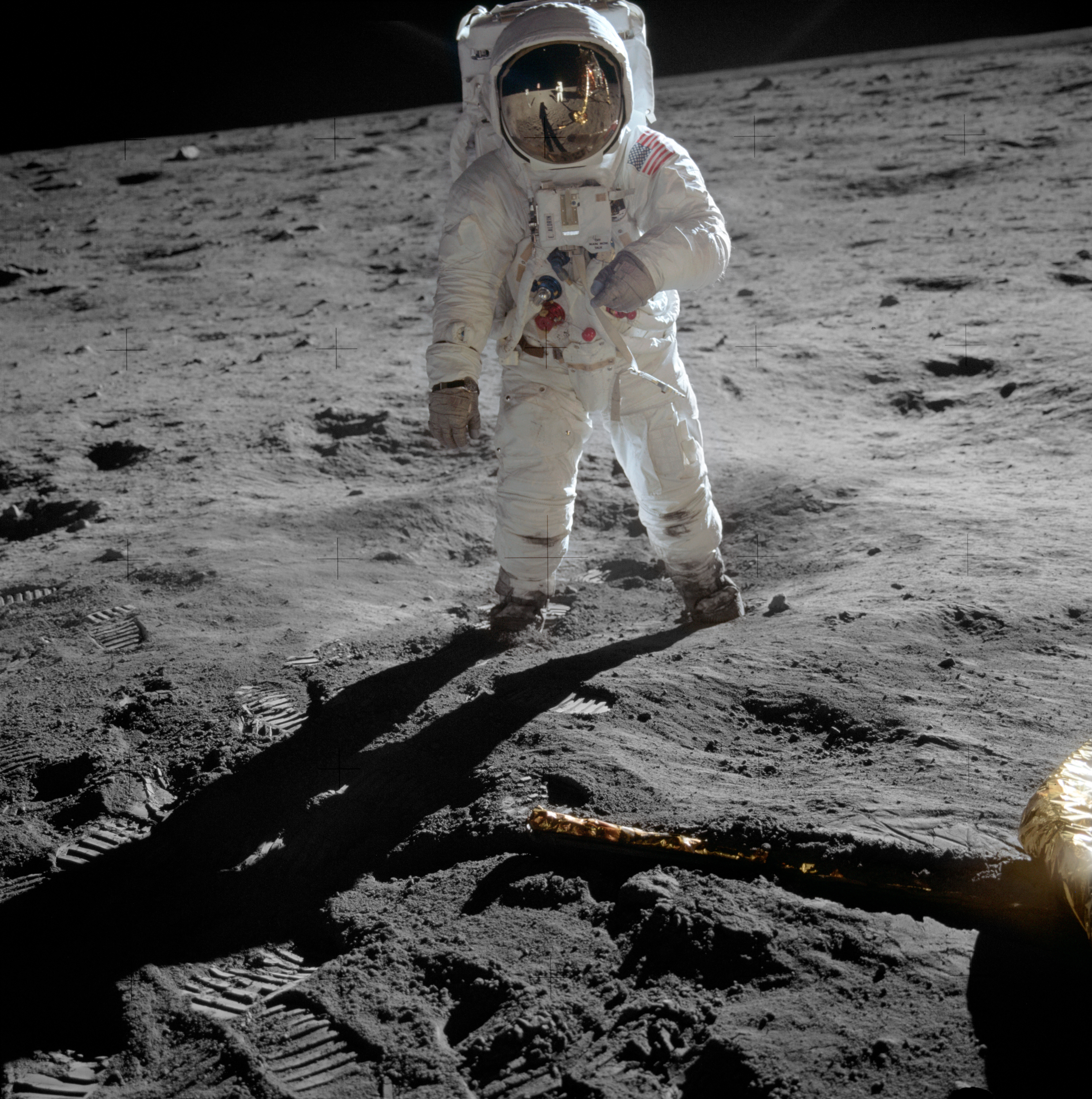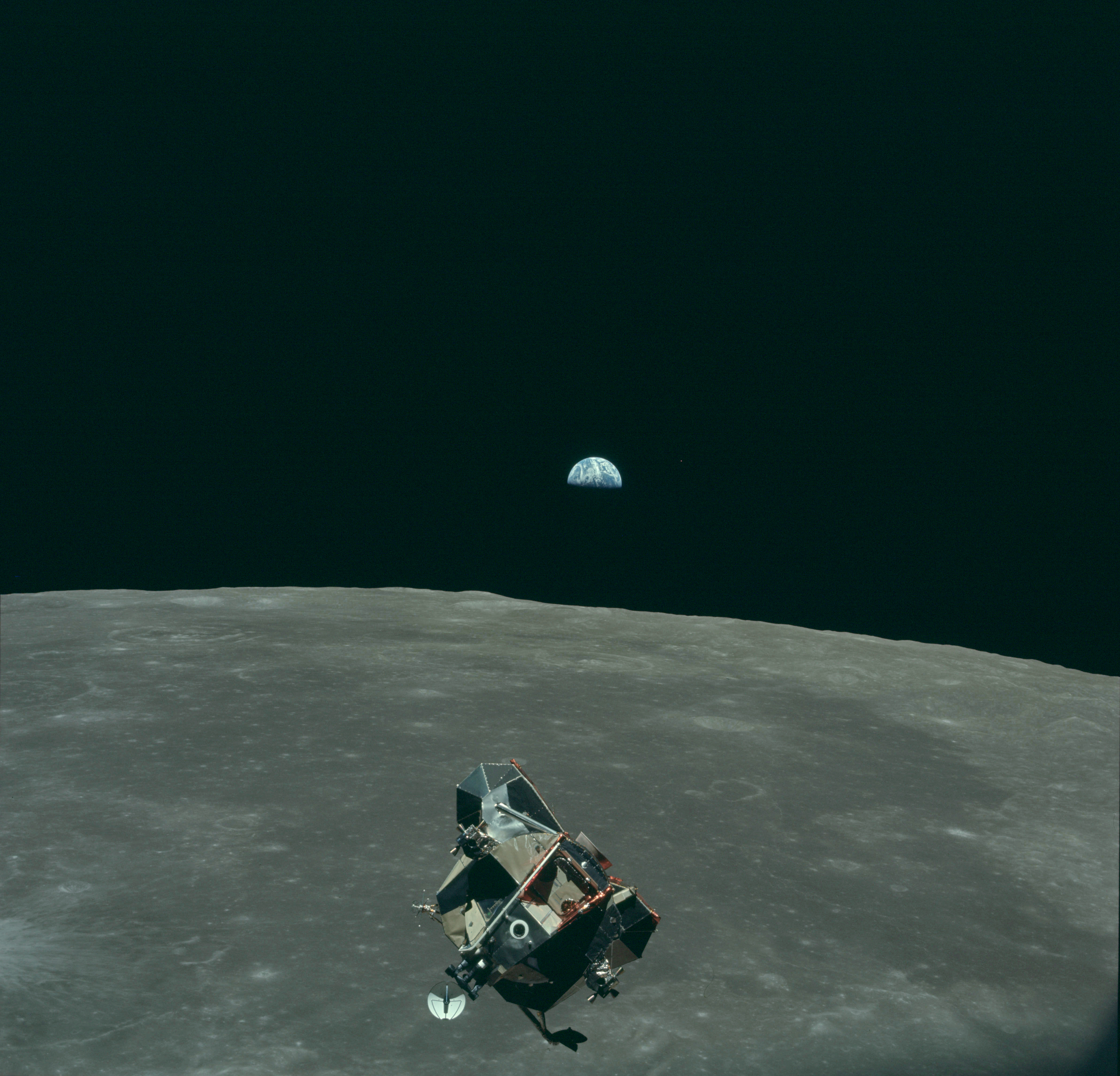|
Apollo 11 Fiftieth Anniversary Commemorative Coins
The Apollo 11 50th Anniversary commemorative coins were issued by the United States Mint in 2019 to commemorate the 50th anniversary of the first crewed landing on the Moon by Apollo 11 astronauts Neil Armstrong and Buzz Aldrin. Consisting of a gold half eagle ($5 coin), two different sizes of silver dollars, and a copper-nickel clad half dollar, each of the four was issued in proof condition, with all but the larger silver dollar also issued in uncirculated. The gold coins were struck at the West Point Mint, the silver at the Philadelphia Mint and the base metal half dollars at the mints in Denver and San Francisco. All four coins have the same design. The obverse depicts a bootprint on the lunar surface, based on a photograph taken by Aldrin. That design is by Maine sculptor Gary Cooper, with engraving by Joseph Menna of the Mint. The reverse, as mandated by Congress, depicts the visor and surrounding helmet of Aldrin's space suit, with Armstrong, the U.S. Flag and the Apoll ... [...More Info...] [...Related Items...] OR: [Wikipedia] [Google] [Baidu] |
United States Mint
The United States Mint is a bureau of the Department of the Treasury responsible for producing coinage for the United States to conduct its trade and commerce, as well as controlling the movement of bullion. It does not produce paper money; that responsibility belongs to the Bureau of Engraving and Printing. The first United States Mint was created in Philadelphia in 1792, and soon joined by other centers, whose coins were identified by their own mint marks. There are currently four active coin-producing mints: Philadelphia, Denver, San Francisco, and West Point. History The Massachusetts Bay Colony established a mint in Boston in 1652. John Hull was Treasurer and mintmaster; Hull's partner at the "Hull Mint" was Robert Sanderson. The historical marker reads: The first authorization for the establishment of a mint in the United States was in a resolution of the Congress of the Confederation of February 21, 1782, and the first general-circulation coin of the United States ... [...More Info...] [...Related Items...] OR: [Wikipedia] [Google] [Baidu] |
Apollo Lunar Module
The Apollo Lunar Module (LM ), originally designated the Lunar Excursion Module (LEM), was the lunar lander spacecraft that was flown between lunar orbit and the Moon's surface during the United States' Apollo program. It was the first crewed spacecraft to operate exclusively in the airless vacuum of space, and remains the only crewed vehicle to land anywhere beyond Earth. Structurally and aerodynamically incapable of flight through Earth's atmosphere, the two-stage lunar module was ferried to lunar orbit attached to the Apollo command and service module (CSM), about twice its mass. Its crew of two flew the complete lunar module from lunar orbit to the Moon's surface. During takeoff, the spent descent stage was used as a launch pad for the ascent stage which then flew back to the command module, after which it was also discarded. Overseen by Grumman, the LM's development was plagued with problems that delayed its first uncrewed flight by about ten months and its first crewed ... [...More Info...] [...Related Items...] OR: [Wikipedia] [Google] [Baidu] |
Project Gemini
Project Gemini () was NASA's second human spaceflight program. Conducted between projects Mercury and Apollo, Gemini started in 1961 and concluded in 1966. The Gemini spacecraft carried a two-astronaut crew. Ten Gemini crews and 16 individual astronauts flew low Earth orbit (LEO) missions during 1965 and 1966. Gemini's objective was the development of space travel techniques to support the Apollo mission to land astronauts on the Moon. In doing so, it allowed the United States to catch up and overcome the lead in human spaceflight capability the Soviet Union had obtained in the early years of the Space Race, by demonstrating: mission endurance up to just under 14 days, longer than the eight days required for a round trip to the Moon; methods of performing extra-vehicular activity (EVA) without tiring; and the orbital maneuvers necessary to achieve rendezvous and docking with another spacecraft. This left Apollo free to pursue its prime mission without spending time develop ... [...More Info...] [...Related Items...] OR: [Wikipedia] [Google] [Baidu] |
Project Mercury
Project Mercury was the first human spaceflight program of the United States, running from 1958 through 1963. An early highlight of the Space Race, its goal was to put a man into Earth orbit and return him safely, ideally before the Soviet Union. Taken over from the US Air Force by the newly created civilian space agency NASA, it conducted 20 uncrewed developmental flights (some using animals), and six successful flights by astronauts. The program, which took its name from Roman mythology, cost $ (adjusted for inflation). The astronauts were collectively known as the "Mercury Seven", and each spacecraft was given a name ending with a "7" by its pilot. The Space Race began with the 1957 launch of the Soviet satellite Sputnik 1. This came as a shock to the American public, and led to the creation of NASA to expedite existing US space exploration efforts, and place most of them under civilian control. After the successful launch of the Explorer 1 satellite in 1958, crewed spacef ... [...More Info...] [...Related Items...] OR: [Wikipedia] [Google] [Baidu] |
NASA
The National Aeronautics and Space Administration (NASA ) is an independent agency of the US federal government responsible for the civil space program, aeronautics research, and space research. NASA was established in 1958, succeeding the National Advisory Committee for Aeronautics (NACA), to give the U.S. space development effort a distinctly civilian orientation, emphasizing peaceful applications in space science. NASA has since led most American space exploration, including Project Mercury, Project Gemini, the 1968-1972 Apollo Moon landing missions, the Skylab space station, and the Space Shuttle. NASA supports the International Space Station and oversees the development of the Orion spacecraft and the Space Launch System for the crewed lunar Artemis program, Commercial Crew spacecraft, and the planned Lunar Gateway space station. The agency is also responsible for the Launch Services Program, which provides oversight of launch operations and countdown management f ... [...More Info...] [...Related Items...] OR: [Wikipedia] [Google] [Baidu] |
The Moon
The Moon is Earth's only natural satellite. It is the List of natural satellites, fifth largest satellite in the Solar System and the largest and most massive relative to its parent planet, with a diameter about one-quarter that of Earth (comparable to the width of Australia (continent), Australia). The Moon is a planetary-mass object with a planetary differentiation, differentiated Terrestrial planet, rocky body, making it a satellite planet under the geophysical definition of planet, geophysical definitions of the term and larger than all known dwarf planets of the Solar System. It lacks any significant Atmosphere of the Moon, atmosphere, hydrosphere, or Magnetic field of the Moon, magnetic field. Its surface gravity is about one-sixth of Earth's at , with Jupiter's moon Io (moon), Io being the only satellite in the Solar System known to have a higher surface gravity and density. The Moon orbits Earth at an lunar distance (astronomy), average distance of , or about 30 tim ... [...More Info...] [...Related Items...] OR: [Wikipedia] [Google] [Baidu] |
John F
John is a common English name and surname: * John (given name) * John (surname) John may also refer to: New Testament Works * Gospel of John, a title often shortened to John * First Epistle of John, often shortened to 1 John * Second Epistle of John, often shortened to 2 John * Third Epistle of John, often shortened to 3 John People * John the Baptist (died c. AD 30), regarded as a prophet and the forerunner of Jesus Christ * John the Apostle (lived c. AD 30), one of the twelve apostles of Jesus * John the Evangelist, assigned author of the Fourth Gospel, once identified with the Apostle * John of Patmos, also known as John the Divine or John the Revelator, the author of the Book of Revelation, once identified with the Apostle * John the Presbyter, a figure either identified with or distinguished from the Apostle, the Evangelist and John of Patmos Other people with the given name Religious figures * John, father of Andrew the Apostle and Saint Peter * Pope Jo ... [...More Info...] [...Related Items...] OR: [Wikipedia] [Google] [Baidu] |
Aldrin Apollo 11 Original
Aldrin is an organochlorine insecticide that was widely used until the 1990s, when it was banned in most countries. Aldrin is a member of the so-called "classic organochlorines" (COC) group of pesticides. COCs enjoyed a very sharp rise in popularity during and after The Second World War. Other noteworthy examples of COCs include DDT. After research showed that organochlorines can be highly toxic to the ecosystem through bioaccumulation, most were banned from use. It is a colourless solid. Before the ban, it was heavily used as a pesticide to treat seed and soil. Aldrin and related "cyclodiene" pesticides (a term for pesticides derived from Hexachlorocyclopentadiene) became notorious as persistent organic pollutants.Robert L. Metcalf "Insect Control" in Ullmann’s Encyclopedia of Industrial Chemistry" Wiley-VCH, Weinheim, 2002. Structure & Reactivity The structure formula of aldrin is C12H8Cl6. The molecule has a molecular weight of 364.896 g/mol. The melting point of aldrin ... [...More Info...] [...Related Items...] OR: [Wikipedia] [Google] [Baidu] |
Coin Of The Year Award
The Coin of the Year Award (COTY) is an awards program founded and annually conducted by the American publisher Krause Publications of Iola, Wisconsin, and directed at the coin producing industry. Awards are given for numismatic design, artistic vision and craftsmanship. A panel of international judges chooses the coins from those issued two years prior to the year of the award."Glow-in-the dark quarter is coin of the year" ''Bayview News'', November 20, 2013 About The COTY was awarded for the first time in 1984, in which coins issued in 1982 were assessed. A panel of judges chooses ten coins to be nominees for each of ten categories. These nominees will then be reviewed by an international panel of judges who are numismatic experts, journalist, authors, coin designers, and mint, ban ...[...More Info...] [...Related Items...] OR: [Wikipedia] [Google] [Baidu] |
National Baseball Hall Of Fame And Museum
The National Baseball Hall of Fame and Museum is a history museum and hall of fame in Cooperstown, New York, operated by private interests. It serves as the central point of the history of baseball in the United States and displays baseball-related artifacts and exhibits, honoring those who have excelled in playing, managing, and serving the sport. The Hall's motto is "Preserving History, Honoring Excellence, Connecting Generations". Cooperstown is often used as shorthand (or a metonym) for the National Baseball Hall of Fame and Museum, similar to "Canton" for the Pro Football Hall of Fame in Canton, Ohio. The Hall of Fame was established in 1939 by Stephen Carlton Clark, an heir to the Singer Sewing Machine fortune. Clark sought to bring tourists to a city hurt by the Great Depression, which reduced the local tourist trade, and Prohibition, which devastated the local hops industry. Clark constructed the Hall of Fame's building, and it was dedicated on June 12, 1939. (His gran ... [...More Info...] [...Related Items...] OR: [Wikipedia] [Google] [Baidu] |
Convex
Convex or convexity may refer to: Science and technology * Convex lens, in optics Mathematics * Convex set, containing the whole line segment that joins points ** Convex polygon, a polygon which encloses a convex set of points ** Convex polytope, a polytope with a convex set of points ** Convex metric space, a generalization of the convexity notion in abstract metric spaces * Convex function, when the line segment between any two points on the graph of the function lies above or on the graph * Convex conjugate, of a function * Convexity (algebraic geometry), a restrictive technical condition for algebraic varieties originally introduced to analyze Kontsevich moduli spaces Economics and finance * Convexity (finance), second derivatives in financial modeling generally * Convexity in economics * Bond convexity, a measure of the sensitivity of the duration of a bond to changes in interest rates * Convex preferences, an individual's ordering of various outcomes Other uses * Convex Co ... [...More Info...] [...Related Items...] OR: [Wikipedia] [Google] [Baidu] |





